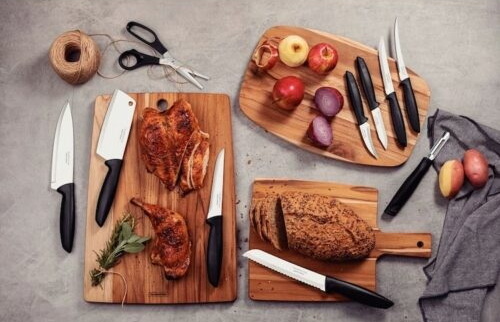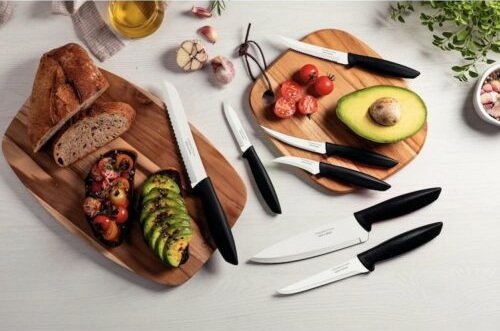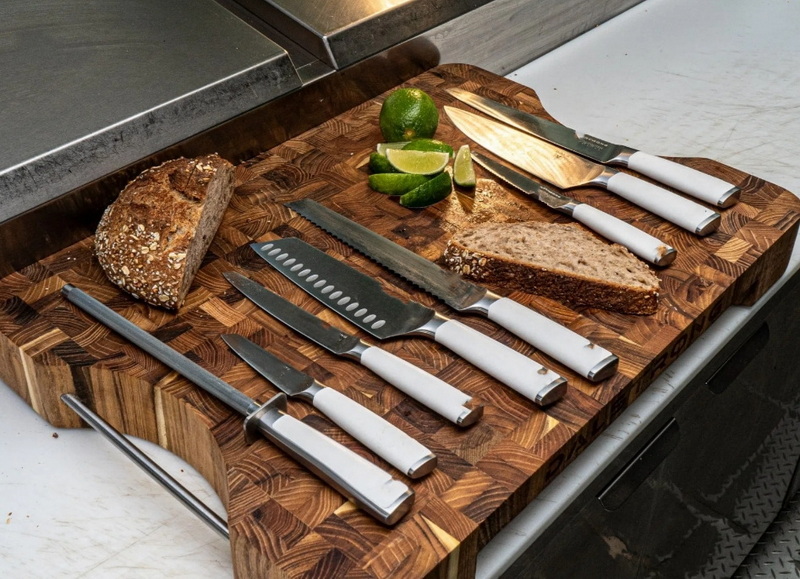

Views: 700 Author: sales@insightknife.com.cn Publish Time: 2025-01-07 Origin: Site








Content Menu
>>> Straight Edge Steak Knives
● The Importance of Keeping Steak Knives Sharp
>> Enhancing the Dining Experience
● Methods for Sharpening Steak Knives
>> Honing Steel
>> Professional Sharpening Services
● Tips for Maintaining Sharp Steak Knives
>> Safe Storage
>> Avoid Cutting on Hard Surfaces
>> Schedule Regular Sharpening
● Frequently Asked Questions regarding Steak Knives Sharp
>> 1. How often should I sharpen my steak knives?
>> 2. What is the best way to clean steak knives?
>> 3. Can I use a honing steel on serrated steak knives?
>> 4. What type of cutting board is best for steak knives?
>> 5. Is it worth investing in a professional sharpening service?
Keeping a steak knife sharp is essential for ensuring a smooth and enjoyable dining experience. A sharp knife not only enhances the presentation of your meal but also makes cutting through meat effortless. In this article, we will explore various aspects of steak knives, including their types, the importance of keeping them sharp, methods for sharpening, and tips for maintenance. By understanding these elements, you can elevate your culinary skills and ensure that your dining experiences are always top-notch.
A steak knife is a specialized knife designed for cutting steak and other meats. Unlike regular kitchen knives, steak knives typically have a serrated or straight edge, allowing for precise cuts without tearing the meat fibers. The design of a steak knife is crucial for both functionality and aesthetics, often featuring a comfortable handle that complements the dining experience. The blade length usually ranges from four to eight inches, providing enough leverage to slice through various types of meat. Additionally, many steak knives are crafted from high-quality stainless steel, which not only enhances their durability but also contributes to their sharpness and resistance to rust.

Steak knives come in various styles, each suited for different preferences and uses. The two primary types are:
Straight edge steak knives have a smooth blade that allows for clean cuts. They are ideal for tender cuts of meat, such as filet mignon, where precision is key. These knives require regular sharpening to maintain their edge. The straight edge design is particularly favored by chefs and culinary enthusiasts who appreciate the control and finesse it offers when slicing through delicate meats. Moreover, straight edge knives can be used for a variety of other tasks in the kitchen, making them versatile tools for any cook.
Serrated steak knives feature a blade with teeth-like edges, making them effective for cutting through tougher meats and crusty bread. The serrations grip the meat, allowing for a sawing motion that reduces the effort needed to cut. While they do not require sharpening as frequently as straight edge knives, they still need proper maintenance to ensure optimal performance. Serrated knives are particularly useful for dining settings where a variety of meats are served, as they can handle everything from grilled steaks to roasted poultry with ease. Their unique design also makes them a popular choice for casual dining, where ease of use is paramount.

A sharp steak knife enhances the overall dining experience. Dull knives can lead to jagged cuts, which not only look unappealing but can also affect the texture and flavor of the meat. A sharp knife allows for clean, precise cuts that preserve the integrity of the meat, making each bite more enjoyable. When guests are served perfectly sliced steak, it not only elevates the meal but also reflects the host's attention to detail and care in preparation. The visual appeal of a well-cut steak can enhance the overall presentation of the dish, making it more appetizing and inviting.
Using a dull knife can be more dangerous than using a sharp one. When a knife is dull, more force is required to cut through food, increasing the risk of slipping and causing injury. A sharp knife, on the other hand, requires less pressure, allowing for better control and reducing the likelihood of accidents. This is particularly important in a busy kitchen environment, where the risk of injury can increase with the use of dull tools. By prioritizing sharpness, cooks can work more efficiently and safely, ensuring a smoother cooking process and a more enjoyable experience for everyone involved.
A whetstone is a traditional method for sharpening knives. It consists of a block of stone with varying grits, allowing for both coarse and fine sharpening. To use a whetstone, follow these steps:
Soak the Whetstone: If using a water stone, soak it in water for about 10-15 minutes before use. This helps to create a slurry that aids in the sharpening process.
Angle the Knife: Hold the knife at a 20-degree angle against the stone. Maintaining the correct angle is crucial for achieving a sharp edge.
Sharpen the Blade: Slide the blade across the stone in a sweeping motion, applying light pressure. Repeat this process on both sides of the blade until the desired sharpness is achieved. The process can take several minutes, depending on the condition of the knife.
Clean the Knife: Wipe the blade clean to remove any metal shavings. This step is important to prevent any debris from affecting the knife's performance during use.
Using a whetstone not only sharpens the blade but also allows for a more personalized approach to knife maintenance, as users can adjust their technique based on the specific needs of their knives.
Honing steel is a tool used to realign the edge of a knife rather than sharpen it. It is essential for maintaining the sharpness of your steak knives between sharpening sessions. To use honing steel:
Hold the Steel Vertically: Place the honing steel in a vertical position, securing it with one hand. This provides stability during the honing process.
Angle the Knife: Hold the knife at a 15-20 degree angle against the steel. This angle is crucial for effective honing.
Hone the Blade: Slide the knife down the steel, applying light pressure. Alternate sides to ensure even honing. This process should be done several times on each side to maintain the knife's edge.
Regular honing can significantly extend the life of your steak knives, ensuring they remain sharp and ready for use at all times. It is a quick and easy maintenance step that can be incorporated into your routine.
Electric knife sharpeners offer a quick and convenient way to sharpen steak knives. These devices typically have built-in guides to help maintain the correct angle. To use an electric sharpener:
Insert the Knife: Place the knife into the designated slot of the sharpener. Ensure that the blade is properly aligned with the sharpening mechanism.
Activate the Sharpener: Turn on the device and allow it to sharpen the blade according to the manufacturer's instructions. Most electric sharpeners will have multiple stages for coarse and fine sharpening.
Check the Sharpness: After sharpening, test the knife on a piece of paper or a tomato to ensure it cuts smoothly. This quick test can help you gauge the effectiveness of the sharpening process.
Electric sharpeners are particularly beneficial for those who may not have the time or skill to sharpen knives manually. They provide consistent results and can be a valuable addition to any kitchen.
For those who prefer not to sharpen their knives at home, professional sharpening services are available. These services use specialized equipment to restore the edge of your steak knives, ensuring they are in optimal condition. Regular professional sharpening can extend the life of your knives and maintain their performance. Many culinary schools and local kitchen supply stores offer sharpening services, making it easy to find a reliable option. Additionally, some chefs recommend scheduling professional sharpening at least once a year, depending on usage, to keep knives in peak condition.

Honing your steak knives regularly is crucial for maintaining their sharpness. It is recommended to hone your knives before and after each use. This practice helps realign the blade and keeps it sharp for longer periods. By incorporating honing into your routine, you can ensure that your knives are always ready for action, reducing the need for frequent sharpening. This simple step can make a significant difference in the performance of your knives, allowing for smoother cuts and a more enjoyable cooking experience.
After each use, clean your steak knives with warm, soapy water and dry them immediately. Avoid placing them in the dishwasher, as the high heat and harsh detergents can damage the blade and handle. Proper cleaning prevents the buildup of food particles and bacteria, ensuring your knives remain in good condition. Additionally, using a soft cloth to dry the knives can help prevent scratches and maintain their appearance. Taking the time to clean your knives properly not only extends their lifespan but also ensures that they are safe and hygienic for food preparation.
Storing your steak knives properly is essential for maintaining their sharpness. Use a knife block, magnetic strip, or blade guards to protect the edges from damage. Avoid tossing them into a drawer, as this can lead to dulling and chipping. Proper storage not only protects the blades but also keeps them organized and easily accessible. A well-organized kitchen can enhance your cooking experience, making it easier to find the right tools when you need them.
When using your steak knives, avoid cutting on hard surfaces such as glass or stone. Instead, use a wooden or plastic cutting board, which is gentler on the blade and helps maintain its sharpness. Hard surfaces can cause nicks and chips in the blade, leading to a dull edge over time. By choosing the right cutting surface, you can prolong the life of your knives and ensure they perform at their best.
Establish a regular sharpening schedule based on how often you use your steak knives. For frequent use, consider sharpening them every few months. For less frequent use, once or twice a year may suffice. Keeping a consistent schedule ensures your knives are always ready for use. Additionally, keeping track of when you last sharpened your knives can help you gauge their performance and determine when they need attention. This proactive approach to knife maintenance can save you time and effort in the long run.
Keeping your steak knives sharp is essential for both safety and enjoyment in the kitchen. By understanding the different types of steak knives, the importance of sharpness, and the various methods for sharpening and maintaining them, you can ensure that your knives remain in excellent condition. Regular honing, proper cleaning, safe storage, and timely sharpening will enhance your culinary experience and make every meal a delight. With these tips, you can enjoy perfectly sliced steak and impress your guests with your attention to detail. Investing time in the care of your steak knives not only improves their performance but also elevates your overall cooking experience, making every meal a memorable occasion.
It is recommended to sharpen your steak knives every few months if you use them frequently. For less frequent use, sharpening once or twice a year may suffice. Regular honing before and after each use can also help maintain their sharpness.
The best way to clean steak knives is to wash them by hand with warm, soapy water and dry them immediately with a soft cloth. Avoid using a dishwasher, as the high heat and harsh detergents can damage the blades and handles.
While honing steel is primarily used for straight-edge knives, it can be used on serrated knives to realign the tips of the serrations. However, it is not as effective as honing a straight-edge knife. For serrated knives, regular sharpening is more important.
A wooden or plastic cutting board is best for steak knives. These materials are gentler on the blade compared to glass or stone surfaces, which can dull the knife more quickly.
Yes, investing in a professional sharpening service can be worthwhile, especially if you have high-quality steak knives. Professionals use specialized equipment to restore the edge effectively, ensuring your knives perform at their best and last longer. Regular professional sharpening can save you time and effort in maintaining your knives.